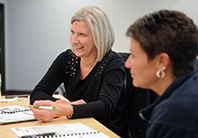Why Coaching is an Important Management Skill
 Gone are the days when managers were just managers. More managers today are encouraged, even expected, to develop themselves as leaders and acquire coaching skills to more effectively manage their teams. Not only does coaching allow you to grow as a leader, it also makes you more attractive when interviewing for a new position. Add the skill of coach to your professional portfolio and you rise to the top of the list of candidates.
Gone are the days when managers were just managers. More managers today are encouraged, even expected, to develop themselves as leaders and acquire coaching skills to more effectively manage their teams. Not only does coaching allow you to grow as a leader, it also makes you more attractive when interviewing for a new position. Add the skill of coach to your professional portfolio and you rise to the top of the list of candidates.
More professionals are being asked to coach their work teams in order to get the most out of their people. Like any relationship, coaching is built on trust and mutual respect. The person you are coaching, the protégé, must trust you to guide him/her though a strategic thinking process. When information is shared openly, the process will be more beneficial.
One of the greatest benefits of coaching others is that it allows you to polish your management skills. Many of the skills of the coach coincide with good management skills. Here’s what it takes to be a successful coach:
- Focus. The coach remains focused on the protégé’s goals and, in turn, keeps the protégé focused on those goals. Within coaching sessions, the coach focuses on the work to be done and keeps the protégé on track through a solid process and effective clarifying questions.
- Mindfulness/presence. The coach is fully present and eliminates any distractions. The more attention you give to the protégé, the more effective your sessions will be.
- Rapport/trust. As the coaching relationship deepens, so does the level of trust between the coach and protégé. Create a safe environment for the exchange of open dialogue and trust will develop over time.
- Confidentiality. The coach clearly states and upholds the commitment to retain all conversations and information in confidence.
- Active listening. The role of the coach is to talk less and listen more. Let the protégé do the talking.
- Intuition. The compassionate coach uses all senses to assess the protégé’s mood or the environment. Sometimes the coach must rely on a “gut” feeling of intuition rather than a more logical, rational explanation.
- Curiosity. The curious crave a deeper way of knowing and drive a deeper level of inquiry. The result: thorough and sensitive questions to reveal breakthroughs in thinking or behavior.
- Sound judgment but not judging. The coach remains non-judgmental and open-minded and is prepared to use sound judgment when helping protégés work through challenges.
- Patience. Behavioral change takes time so it requires patience. Understand that each protégé works in her/his own timeframe. Some protégés require greater time to sort out issues and develop solutions and strategies.
- Synthesis. After listening to the protégé, the coach weaves together the strands of information, sometimes disparate, and creates a seamless, condensed summary. Some would call it the 30,000-foot perspective. Often the protégé cannot see what is most obvious. It takes a skilled coach to point it out. When a protégé says, “I never thought of it this way” or “I can’t believe I never saw that before,” the coach knows the protégé is viewing things differently and can now take action.
As a coach, it is helpful to clarify your role. In my experience as a coach, specializing in professional/executive presence, strategic communication and presentation skills, I have learned firsthand what it takes to be an effective coach. Here are a few extra tips to help you become the best coach at work:
- Create a safe space for open dialogue. You set the tone, as coach, from the beginning of the coach-protégé relationship. Communicate openly and honestly, and let the protégé know that the environment you are creating is a safe one.
- Be an equal “partner” with the person being coached. You have just as much to gain from the coaching relationship as the protégé. You are using new skills and polishing existing skills each time you meet with the protégé.
- Focus on the needs of the protégé. A good coach recognizes the gem that lies beneath the surface. The coach can often see things that the protégé can’t. If you are helping your protégé to become a greater leader, then make an honest assessment up front. See where the gaps exist. Work with the protégé to create an action plan for improvement. Support the protégé’s goals and action plan.
- Remain objective and neutral. This is a tough one. It’s hard to be objective and neutral, especially when you are coaching someone who is a member of your team. Go beyond your natural subjective self and try to look at the protégé with fresh eyes. See who is sitting in front of you. Even though you have an emotional attachment to the person, try to separate those emotions from your task at hand as the coach. Sometimes you have to step outside yourself to get a clear objective and neutral perspective. It may help to ask yourself, “If I were a customer, what would I see or experience right now?”
- Ask lots of questions, especially open-ended, clarifying or inviting questions, such as:
“What do you think would happen if…”
“How does this support your values?”
“What other options do you see?”
“What is holding you back?”
“How could you make that happen?”
“What is the number one priority you will focus on this month?”
“What is another approach that you could take?”
Seeking understanding through questions is more productive than directing a protégé on what to do. Remember, the coach is committed to helping with the protégé’s professional development.
By seeking greater understanding of the protégé’s needs, helping with goals and staying focused, you also will find yourself naturally becoming more focused on your needs, goals and outcomes. It’s a win-win for the coach and protégé.

